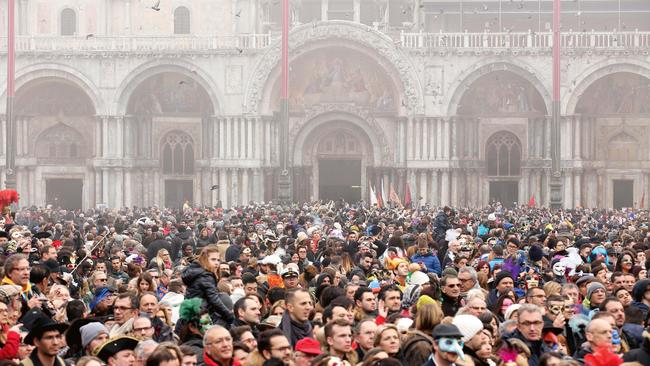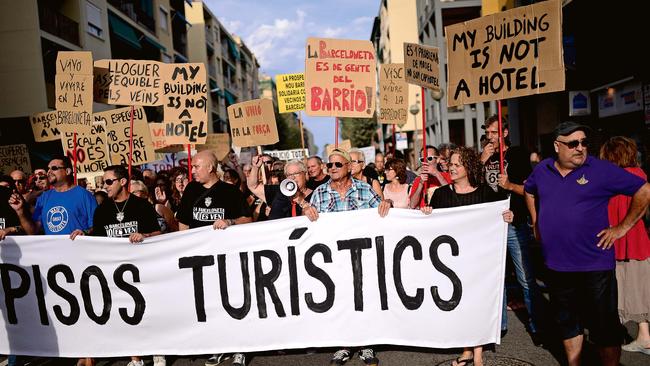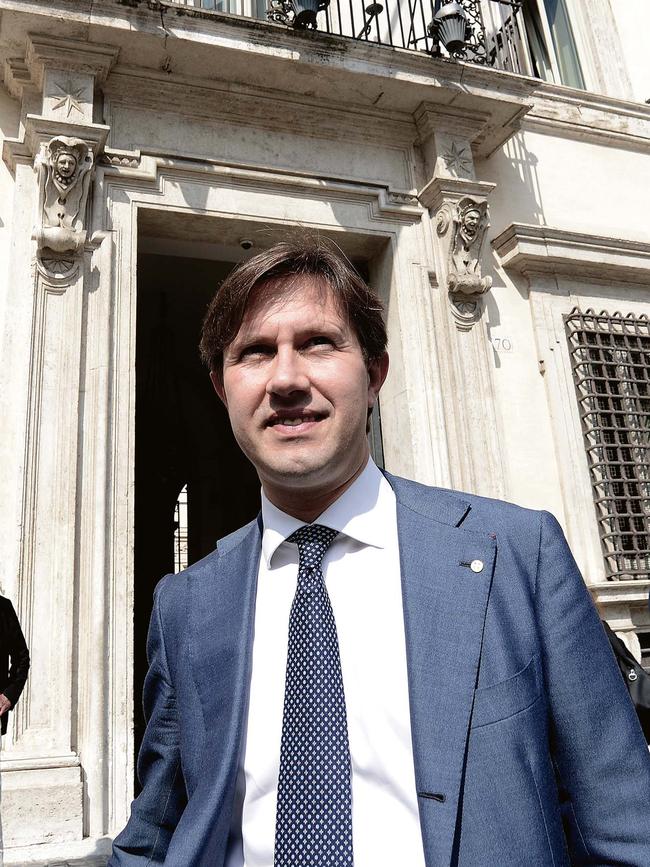Under siege: the downside of mass tourism
The world is awash with tourists — and cities such as Venice are being forced to take drastic action.

Venice is facing not one rising tide, but two: the first is the water eating away at the foundations of La Serenissima; the second is the tidal wave of tourists threatening to engulf the lagoon city. At the annual Venice carnival in February, barriers were placed at the entrances to St Mark’s Square to limit the numbers surging into the piazza. The 110,000 visitors who poured into Venice outnumbered the locals by two to one, but only 23,000 were allowed into the piazza, giving each person a roomy half square metre of space.
This year Venice will start charging tourists to the city an entry fee: €3 ($4.70) in the low season and €10 ($15.70) at the height of summer. The move has been approved by the Italian government as a way to recoup the costs of clearing up the damage and rubbish left by 24 million annual tourists, many of whom arrive on day trips, contributing little to the city’s economy.
Venetians have been complaining of being overrun by foreigners since at least 1797, when the fall of the Venetian Republic led to an unwelcome influx of French and Austrians. But the city’s decision to restrict numbers and charge for admission to an open space is reflective of a much wider problem, not just in Italy but at popular tourist destinations around the world.
The world is awash with tourists for a variety of reasons: stronger economic growth, more affordable travel, digital innovations such as Airbnb, a swelling middle class, easier visa systems, bigger planes and ships, changing leisure habits and wider cultural horizons. The UN World Tourism Organisation reports that international tourism leapt 6 per cent in 2018, nearly double the growth in the global economy, with 1.4 billion international tourist arrivals — a figure that economists did not expect to be breached for another two years. An additional 200 million people have headed abroad in the past three years. Tourism now accounts for nearly 3 per cent of the world’s GDP and employs 5 per cent of the global workforce.
The Chinese are coming too. Only 10 per cent of Chinese citizens hold passports but the China Outbound Tourism Research Institute predicts that by 2030, 400 million will head abroad for their holidays. The world is on the move, with selfie-stick in hand. Last year the Oxford English Dictionary pronounced “overtourism” one of its new words of the year, defining it as “The phenomenon of a popular destination or sight becoming overrun with tourists in an unsustainable way”.
In many ways, overtourism should be celebrated. The Brookings Institute estimates the global middle class has swelled to 3.7 billion people. Many of them do not just want to spend their money at home, or hoard it, or visit only Disneyland, but would rather use it to discover the wider world, learn and admire. Most countries welcome increased tourism and the revenue it brings. But in some parts of the world tourism is reaching peak capacity, with consequences that include chronic overcrowding, damage to fragile sites, cultural and physical disruption for local people and a degraded experience for the tourists themselves.

Locals in prime tourist hotspots complain of noise pollution, crowded parks, pressure on public facilities and rising rents, with the Airbnb revolution warping house prices. Some 1200 properties were listed on Airbnb in Reykjavík at the height of the season in 2017, more than the total number of new homes built in the city that year. In Barcelona, the mayor ran for election on a promise to manage overcrowding. According to the World Travel & Tourism Council, overtourism has caused power failures and water shortages in the Philippines and an overloaded sewerage system in the Indian desert city of Jaisalmer. In the most overvisited places, travellers are driving out the locals, who are priced out of their homes to accommodate demand: the population of Venice has roughly halved in the past 30 years.
The problem is not the new army of tourists per se but their desire to see the same things, at the same time, in the same way: this is producing spectacular bottlenecks in a restricted number of places. The new hordes are not, usually, heading for the empty spaces of the world: they are going to places already overflowing with people. While the internet might have been expected to introduce world travellers to new and dispersed destinations, it appears to be helping to funnel them into a small number of must-see hotspots.
The backlash has begun. Last year President Duterte of the Philippines closed the island of Boracay because too many visitors, and too few sewage pipes, had turned it into a “cesspool”. To follow Peru’s Inca Trail, you now need a permit, and only 500 are available a day. Thailand’s Koh Tachai island and Maya Bay on Koh Phi Phi Leh were closed to the public to give them time to recover from a thumping tourist footfall.

Venice’s plan to sell entry tickets may soon spread to other parts of Italy. Florence’s mayor, Dario Nardella, wants to extend the policy to his own city, as well as Rome, Naples, Palermo and other popular destinations. “What the government has done in Venice is a great idea and can be a template for a national law that introduces a tourist congestion charge across Italy,” he said.
If the experience of being crammed into an overvisited venue is dismaying and uncomfortable for the tourist, it can be even more infuriating for the people who live there. Last summer protesters attacked tourist buses in Majorca and Valencia. Anti-tourism street marches have occurred in Venice and Ibiza. In Barcelona, graffiti declared, “Tourists go home, refugees welcome”.
Cruise ships have been targeted, too. The Croatian city of Dubrovnik now permits only two cruise ships a day to dock, while limiting the numbers of visitors allowed to enter the old city, many of whom are drawn to it as the fictional King’s Landing in Game of Thrones. The island of Santorini has cut the maximum number of day-trippers by one third to 8000. Cruise passengers disembarking in Amsterdam must pay €8 ($12.50) a day to visit the city. Locals point out that when 3000 passengers pour in from a single vessel, stock up on souvenirs and depart after just a few hours, it really does feel like a scene from Game of Thrones.
Inevitably, social media has played a role. The selfie, Facebook and Instagram have created a culture that requires the traveller to be pictured in a place others will recognise and admire: in other words, St Mark’s Square rather than the beautiful and almost empty church around the corner. The rise of the bucket-list mentality, setting a social premium on specific destinations, means thousands converge on the same place to take photographs of themselves alongside others doing the same thing.
For under-visited countries, regions and sites, tourism offers a huge boon and a major employment opportunity, since the factors that encourage visitors can also lure foreign investment. The answer is to persuade tourists that instead of visiting the obvious places, the standard exhibitions, the icons such as the Mona Lisa that are already pictured on a million postcards, there is more to discover and more enjoyment to be found (and perhaps even more “likes” to garner on social media) in the less obvious destination or artwork.
With the most popular tourist spots reaching bursting point and a vast wave of Chinese tourism on the horizon, this may already be happening. According to a recent McKinsey report Chinese tourists, though ever more numerous, are becoming more discerning, moving away from coach tours and binge-shopping. The world needs to develop more diverse travel habits, because the alternative is nightmarish: a hugely expensive, time-specific ticket to St Mark’s, a turnstile manned by the tourist police, and a conveyor belt that carries you, slowly but firmly, around the perimeter of the great piazza, before depositing you, exactly 30 minutes later, on the outside.

To join the conversation, please log in. Don't have an account? Register
Join the conversation, you are commenting as Logout